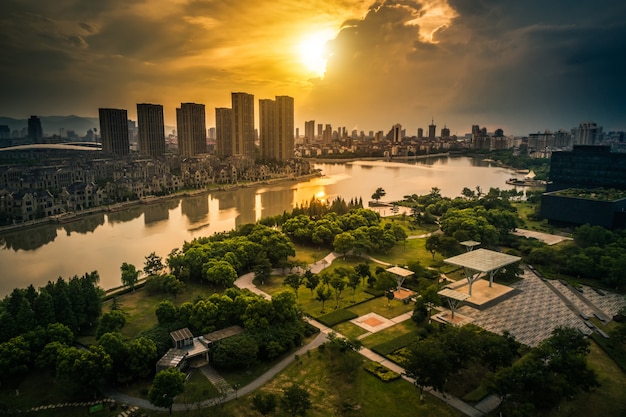Miami, once a modest town, has metamorposed into a thriving global city, enticing residents and visitors alike with its vibrant culture and cosmopolitan charm. Over the years, Miami has experienced a remarkable evolution, reshaping itself into a world-renowned destination.
Historical background of Miami
- Miami’s journey from a small settlement to a global city can be traced back to its historical roots. Originally inhabited by indigenous tribes, the area was later settled by Spanish explorers in the 16th century. However, it wasn’t until the late 19th century that Miami began to gain prominence. The arrival of industrialist Henry Flagler and the extension of the Florida East Coast Railway transformed the city into a transportation hub, connecting it to other major cities in the region. This development laid the foundation for Miami’s future growth.
- As Miami continued to develop, it attracted a diverse range of settlers, including immigrants from Cuba, the Bahamas, and other Caribbean countries. Their influence can still be seen today, with Miami’s vibrant Latin American and Caribbean culture shaping the city’s identity.
Factors that contributed to Miami’s growth
- Several factors contributed to Miami’s rapid growth and transformation. One of the key drivers was its strategic location as a gateway to the Americas. Situated at the crossroads of the United States and Latin America, Miami became a natural hub for international trade and commerce. Its proximity to major shipping lanes and its well-connected transportation infrastructure further enhanced its appeal.
- Another factor that played a significant role in Miami’s growth was its favorable climate. With its warm temperatures and abundant sunshine, Miami became an attractive destination for tourists, retirees, and those seeking a year-round outdoor lifestyle. Its stunning beaches and recreational activities became major draws for visitors from around the world.

Miami’s transition from a small town to a tourist destination
- Miami’s transformation into a tourist destination can be attributed to a combination of factors. The city’s natural beauty, with its pristine beaches and clear blue waters, has always been a major draw. In the early 20th century, the development of luxury hotels and resorts along Miami Beach attracted affluent visitors, establishing the city as a glamorous vacation spot.
- The city’s entertainment and nightlife scene also contributed to its popularity. From the iconic art deco buildings of South Beach to the vibrant clubs and bars of downtown Miami, the city became synonymous with luxury and entertainment. Celebrities and artists flocked to Miami, further enhancing its image as a glamorous destination.
The role of real estate development in Miami’s transformation
- Real estate development has played a crucial role in Miami’s transformation from a small town to a global city. The city’s booming real estate market has attracted investors from around the world, leading to the construction of iconic skyscrapers and luxury condominiums. Miami’s skyline is now dominated by sleek high-rises, reflecting the city’s modern and cosmopolitan image.
- The influx of investment in real estate has not only boosted Miami’s economy but also created employment opportunities and driven urbanization. However, it has also raised concerns about gentrification and affordable housing, as rising property prices have made it challenging for some residents to afford living in the city.
The impact of the arts and culture scene on Miami’s global image
- Miami’s vibrant arts and culture scene has played a significant role in shaping its global image. The city is home to numerous world-class museums, such as the Pérez Art Museum Miami and the Frost Museum of Science. Its annual Art Basel Miami Beach event attracts renowned artists and art enthusiasts from around the world, turning the city into an international art hub.
- In addition to visual arts, Miami has a thriving music and performing arts scene. The city hosts major music festivals like Ultra Music Festival and the Miami International Jazz Festival, making it a must-visit destination for music lovers. Its diverse cultural events, such as the Calle Ocho Festival and the Miami Carnival, showcase the city’s multicultural heritage.
Miami as a hub for international trade and finance
- Miami’s strategic location and well-developed infrastructure have positioned it as a major hub for international trade and finance. The city’s ports handle a significant volume of imports and exports, particularly with Latin America and the Caribbean. As a result, Miami has become an important center for logistics and distribution, attracting businesses and entrepreneurs from around the world.
- Moreover, Miami’s status as a global financial hub has grown in recent years. The city is home to numerous international banks, investment firms, and financial institutions, making it an attractive destination for finance professionals. Its favorable tax environment and business-friendly policies have further contributed to its appeal as a global financial center.
Miami’s diverse and multicultural population
- Miami’s evolution into a global city is evident in its diverse and multicultural population. The city’s residents come from a wide range of cultural backgrounds, including Cuban, Haitian, Colombian, and Venezuelan, among others. This multiculturalism has shaped Miami’s identity and contributed to its vibrant cultural scene.
- Furthermore, Miami’s diverse population has fostered a spirit of entrepreneurship and innovation. The city is known for its thriving startup ecosystem, attracting tech entrepreneurs and investors from around the world. The presence of multinational corporations and industry leaders in sectors such as healthcare, finance, and technology has further contributed to Miami’s reputation as a global business hub.
Challenges and issues faced by Miami as a global city
- While Miami has experienced remarkable growth and success, it also faces challenges as a global city. One of the significant issues is climate change and its impact on the city’s vulnerability to rising sea levels and extreme weather events. Miami’s low-lying geography makes it particularly susceptible to the effects of climate change, necessitating investments in infrastructure and sustainability measures.
- Another challenge is the growing wealth inequality and lack of affordable housing. As property prices continue to rise, many residents struggle to find affordable housing options, leading to social and economic disparities. Addressing these issues requires proactive policies and investments in affordable housing and community development.
Conclusion – Miami’s continued growth and future prospects
Miami’s evolution from a small town to a global city is a testament to its adaptability and resilience. The city’s strategic location, favorable climate, booming economy, and vibrant culture have attracted people from around the world, making it a truly cosmopolitan destination.
As Miami continues to grow, it must address the challenges that come with urbanization and maintain a balance between economic development and sustainability. By investing in infrastructure, affordable housing, and environmental initiatives, Miami can secure its place as a leading global city for years to come.
Miami’s journey is far from over, and its future prospects are bright. With its unique blend of cultures, stunning natural beauty, and dynamic business environment, Miami will continue to captivate the world and evolve into an even more vibrant and prosperous global city.




